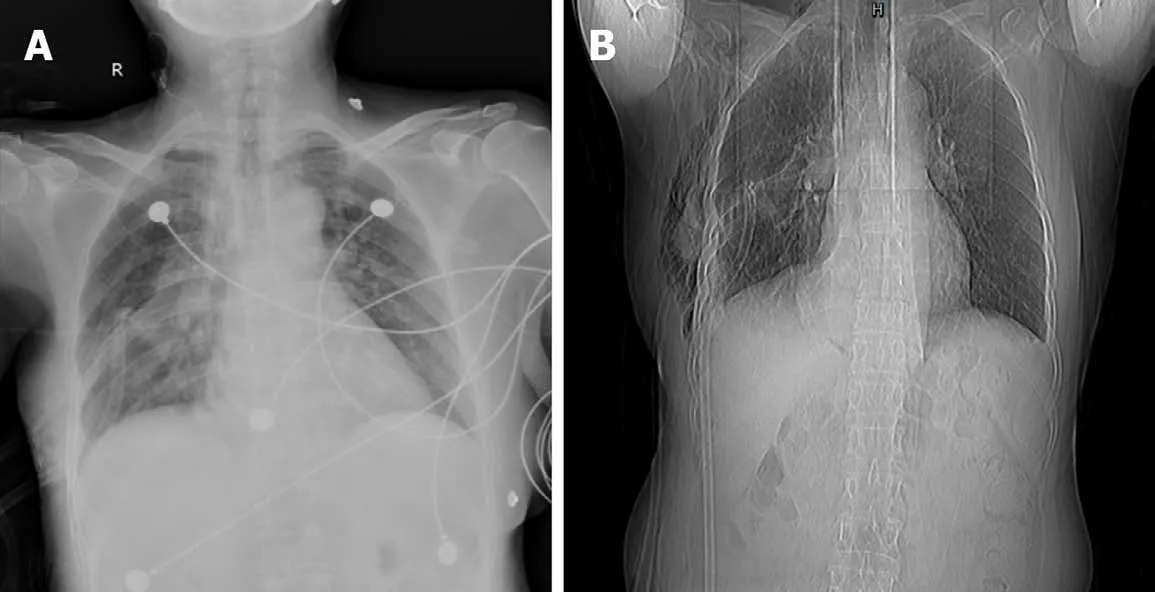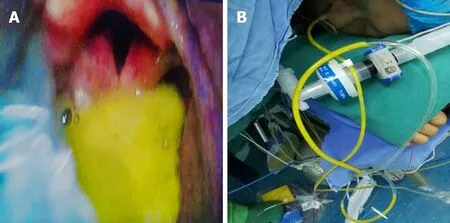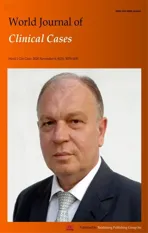Aspiration pneumonia during general anesthesia induction after esophagectomy: A case report
2020-04-07JiaXiTangLingWangWeiQiNianWanYanTangJingYuXiaoXiXiTangHongLiangLiu
Jia-Xi Tang, Ling Wang, Wei-Qi Nian, Wan-Yan Tang, Jing-Yu Xiao, Xi-Xi Tang, Hong-Liang Liu
Jia-Xi Tang, Jing-Yu Xiao, Xi-Xi Tang, Hong-Liang Liu, Department of Anesthesiology, Chongqing Key Laboratory of Translational Research for Cancer Metastasis and Individualized Treatment,Chongqing University Cancer Hospital, Chongqing 400030, China
Ling Wang, Wei-Qi Nian, Wan-Yan Tang, Department of Phase I Clinical Trial Ward, Chongqing Key Laboratory of Translational Research for Cancer Metastasis and Individualized Treatment,Chongqing University Cancer Hospital, Chongqing 400030, China
Abstract BACKGROUND Esophageal cancer is a common malignant tumor of the digestive system. At present, surgery is the most important treatment strategy. After esophagectomy and gastric esophagoplasty, the patients are prone to regurgitation. However,these patients currently do not receive much attention, especially from anesthesiologists.CASE SUMMARY A 55-year-old woman was scheduled for right lower lung lobectomy. The patient had undergone radical surgery for esophageal cancer under general anesthesia 6 mo prior. Although the patient had fasted for > 17 h, unexpected aspiration still occurred during induction of general anesthesia. Throughout the operation,oxygen saturation was 98%-100%, but the airway pressure was high (35 cmH2O at double lung ventilation). The patient was sent to the intensive care unit after surgery. Bedside chest radiography was performed, which showed exudative lesions in both lungs compared with the preoperative image. After surgery,antibiotics were given to prevent lung infection. On day 2 in the intensive care unit, the patient was extubated and discharged on postoperative day 7 without complications related to aspiration pneumonia.CONCLUSION After esophagectomy, patients are prone to regurgitation. We recommend nasogastric tube placement followed by rapid sequence induction or conscious intubation.
Key Words: Aspiration pneumonia; Esophagectomy; Gastric esophagoplasty; Respiratory aspiration; General anesthesia; Case report
INTRODUCTION
Esophageal cancer ranks eighth and sixth for morbidity and mortality, respectively,worldwide[1]. At present, surgery is the most important treatment, but even though surgical techniques are much improved, the incidence of postoperative complications is still high. Esophagectomy and gastric esophagoplasty for esophageal cancer cause reduction of gastric volume, removal of the esophageal sphincter, and impairment of vagal innervation of the stomach, so regurgitation and delayed gastric emptying after esophageal cancer surgery are two common complications[2,3].
However, these patients do not currently attract much attention, especially from anesthesiologists. Here, we report a patient who had undergone esophagectomy and gastric esophagoplasty before being scheduled for elective right lung lobectomy.Regurgitation and aspiration developed during induction of general anesthesia.
CASE PRESENTATION
Chief complaints
A 55-year-old woman was admitted to our hospital with complaints of a nodule of the lower lobe of the right lung found 1 mo ago.
History of present illness
The patient had undergone radical surgery for esophageal cancer 6 mo prior. The patient was admitted to the hospital for routine re-examination for esophageal cancer 1 mo ago. Through chest computed tomography (CT) a nodule of the lower lobe of the right lung was found. The patient denied any symptoms such as coughing and hemoptysis.
History of past illness
The patient had a history of coronary heart disease and right mastectomy. She had undergone radical surgery for esophageal cancer under general anesthesia 6 mo ago.During esophagectomy and gastric esophagoplasty, the esophagus was completely removed and replaced with a 2.5 cm diameter gastric tube, which started from the gastric antrum and anastomosed on the left neck.
Physical examination
On physical examination, patient's lungs breath sounds were clear and symmetrical on auscultation.
Laboratory examinations
Preoperative blood gas analysis showed pH 7.43, partial pressure of carbon- dioxide 40.00 mmHg and partial pressure of oxygen 75.00 mmHg. Blood tests showed slightly low levels of hemoglobin (102 g/L; normal: ≥ 115 g/L). The results of blood biochemistry tests, coagulation function test, myocardial enzymes, urinalysis and stool analysis were normal.
Imaging examinations
The preoperative esophagography showed that the contrast agent passed smoothly through the esophagogastric anastomosis, and no local fistula was observed(Figure 1A). Preoperative chest CT revealed a 2.0 cm × 1.5 cm × 0.5 cm nodule in the lower lobe of the right lung with no active lung lesion (Figure 1B), and gastric tube mild dilatation was shown (Figure 1C). Preoperative lung function, cardiac ultrasound and electrocardiography were normal. Immediate postoperative chest X-ray showed ill-defined frosted hyaline shadow with exudative lesions in both lungs (Figure 2A). At postoperative day 6, chest X-ray showed that the exudative lesions in both lungs were markedly reduced (Figure 2B).
Surgery and anesthesia procedures
Before surgery, no premedication was given, the nasogastric tube was not placed and fasting was > 17 h. On admission to the operating room, heart rate, blood pressure,oxygen saturation (SpO2) and electrocardiography were monitored, and pure oxygen was administered at 8 L/min through a face mask. Three minutes later, 0.3 mg/kg sufentanil, 2 mg midazolam, 2 mg/kg propofol, 4 mg dexamethasone, 50 mg rocuronium and 40 mg lidocaine were administered intravenously for induction of general anesthesia. Mask ventilation was conducted, and the airway pressure was below 20 cmH2O. A video laryngoscope (Insight iS3; Insighters, Shenzhen, China) was inserted to expose the glottis for intubation, and yellow-green gastric content was found in the pharyngeal cavity (Figure 3A). We immediately withdrew the content and intubated the patient with a 35 Fr left-side double-lumen endobronchial tube, and 20 mL yellow-green fluid was withdrawn through the tube. A nasogastric tube was inserted into the stomach, and 100 mL liquid was drained out (Figure 3B). Throughout the procedure, SpO2was 98%-100%, but the airway pressure was high (35 cmH2O at double lung ventilation). To manage the high airway pressure, 100 mg salbutamol was administered through the endobronchial tube, and 0.125 g aminophylline and 100 mg hydrocortisone were administered intravenously. One lung ventilation was performed with fraction of inspired oxygen of 50% and SpO2of 98%-100%. Blood gas analysis showed pH 7.21, partial pressure of carbon dioxide 61.1 mmHg and partial pressure of oxygen 232.9 mmHg. At the end of the 2 h operation, the airway pressure at double lung ventilation was 19 cmH2O. The patient was sent to the intensive care unit (ICU)after surgery without removing the double-lumen endotracheal tube.
Bedside chest radiography was performed immediately in the ICU and showed exudative lesions in both lungs compared with the preoperative image (Figures 1B and 2A). Blood gas analysis showed pH 7.27, partial pressure of carbon dioxide 41.7 mmHg and partial pressure of oxygen 133.0 mmHg. After surgery, the antibiotic piperacillin/tazobactam was given for 3 d to prevent lung infection.
FINAL DIAGNOSIS
Aspiration pneumonia.
TREATMENT
We immediately withdrew the reflux from the throat and intubated the patient with an endobronchial tube to protect the airway and sucked the reflux through the tracheal tube. A nasogastric tube was inserted into the stomach to drain gastric fluid. To manage the high airway pressure during the operation, 100 mg salbutamol was administered through the endobronchial tube, and 0.125 g aminophylline and 100 mg hydrocortisone were administered intravenously. After surgery, the antibiotic piperacillin/ tazobactam was given for 3 d to prevent lung infection.

Figure 1 Preoperative examination. A: Preoperative esophagography showed patency of the reconstructed esophagus and no local fistula; B: Preoperative chest computed tomography showed right lung lower lobe nodules with no active lung lesion; C: Preoperative chest computed tomography showed gastric tube mild dilatation.

Figure 2 Postoperative examination. A: Immediate postoperative chest X-ray showed ill-defined frosted hyaline shadow with exudative lesions in both lungs; B:At postoperative day 6, follow-up chest X-ray showed exudative lesions in both lungs were markedly reduced.

Figure 3 A video laryngoscope. A: Reflux of yellow-green gastric fluid into the pharyngeal cavity; B: Nasogastric tube to drain approximately 100 mL of yellow-green liquid.
OUTCOME AND FOLLOW-UP
On day 2 in the ICU, the patient was extubated, and discharged on day 7 after surgery without complications related to aspiration pneumonia (Figure 2B).
DISCUSSION
Although the incidence of perioperative aspiration pneumonia is low, it can cause severe pulmonary complications and even death[4]. Chest CT of aspiration pneumonia often shows multifocal consolidation, bronchial inflation and patchy ground-glass opacity[5].From this case, it can be found that the right lung exudation was more serious than the left side. We speculate that the possible reason is that the right lung bronchial angle is smaller, and the gastric content is easier to enter the right side[5]. In addition, the operation of the right lower lobe of our patient may also be the cause of heavier right lung exudation.
To prevent perioperative aspiration pneumonia, we usually pay attention to patients’ fasting before surgery. For emergency patients with full stomachs, we also maintain a high level of vigilance against perioperative aspiration pneumonia.However, for patients undergoing elective surgery and sufficient fasting before surgery, our vigilance against aspiration pneumonia may be reduced. Radical resection of esophageal cancer is the main treatment for esophageal cancer, and esophageal reconstruction after esophagectomy is a major problem for esophageal surgery. At present, the gastric tube replacement of the esophagus is mainly used clinically[6]. During esophagectomy and gastric esophagoplasty, the esophageal sphincter is removed. During the process of making the gastric tube, the gastric vagus nerve is excised, and gastric peristalsis is reduced. Additionally, the gastric tube is placed in the chest and may be in a state of passive expansion[7]. In the present case, we found that the patient had gastric tube mild dilatation before surgery (Figure 1C)[8].These factors lead to delayed gastric emptying and an increase in the incidence of gastroesophageal reflux[7,9,10].
At present, for the prevention of aspiration pneumonia, there are many methods to be recommended: Nasogastric tube placement; high head induction; rapid sequence induction with cricoid pressure and mask free ventilation and conscious tracheal intubation[11]. There are also some controversies regarding the above measures. The purpose of nasogastric tube insertion is to reduce the pressure in the stomach, but there are also concerns that the cardia cannot be closed and about the ineffectiveness of cricoid pressure. Therefore, whether the nasogastric tube is still in place during anesthesia induction is controversial[12]. Induction in high head position can increase the pressure difference between the stomach and pharyngeal cavity and can theoretically reduce the occurrence of reflux. Therefore, if the anesthesia is induced in high head position and regurgitation still occurs, the possibility of aspiration may be higher. Therefore, when faced with patients with high risk of reflux aspiration, some anesthesiologists tend to use head-down induction[13]. The technique of cricoid pressure was first proposed by Sellick in 1961 and can largely prevent reflux of gastroesophageal contents[14]. However, variation in individual anatomy and anatomical abnormalities caused by neck anastomosis in esophageal cancer surgery may make cricoid pressure ineffective[15]. At present, ultrasound visualization has been widely used in anesthesia, and it is worth trying ultrasound-guided cricoid pressure[16]. The use of gastric ultrasound to assess gastric contents before induction may help guide anesthesia strategies[17]. However, the use of ultrasound to assess gastric contents for this case whose gastric tube in the thoracic cavity may be very difficult. In our case, due to lack of experience, we failed to give the patient rapid sequence induction with maskless ventilation. However, even if we did, aspiration could not be completely avoided[18,19]. The nasogastric balloon tube may be a good alternative to rapid sequential induction and awake intubation[20], but whether it is effective in patients undergoing esophagectomy remains to be verified. In addition,since the severity of aspiration pneumonia is related to pH and amount of gastric content[21], the prophylactic use of stomach stimulants and acid inhibitors may reduce mortality of aspiration pneumonia[22].
CONCLUSION
After esophagectomy and gastric esophagoplasty, there is a high risk of aspiration pneumonia during the perioperative period. There is still insufficient evidence to support the use of various methods to prevent aspiration in this high-risk group.However, aspiration pneumonia is closely related to postoperative mortality and pulmonary complications, so anesthesiologists should pay more attention to such patients. Based on current evidence, we recommend nasogastric tube placement before induction followed by rapid sequence induction or conscious intubation for these patients to prevent aspiration pneumonia.
杂志排行
World Journal of Clinical Cases的其它文章
- Strategies and challenges in the treatment of chronic venous leg ulcers
- Peripheral nerve tumors of the hand: Clinical features, diagnosis,and treatment
- Treatment strategies for gastric cancer during the COVID-19 pandemic
- Oncological impact of different distal ureter managements during radical nephroureterectomy for primary upper urinary tract urothelial carcinoma
- Clinical characteristics and survival of patients with normal-sized ovarian carcinoma syndrome: Retrospective analysis of a single institution 10-year experiment
- Assessment of load-sharing thoracolumbar injury: A modified scoring system
